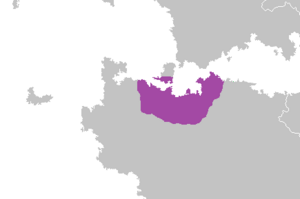Ancient Symmeria
Μακεδονία | |
|---|---|
| 556–246 BCE1 | |
|
Flag | |
 | |
| Capital | Parilla |
| Common languages | Ancient Makedonian |
| Demonym(s) | Makedonian |
| Government | Absolute Monarchy |
| King | |
| History | |
• Established | 556 |
• Formation of the Makedonian Empire | 246 BCE1 |
| Currency | Drachma |
| |
In historiography, Ancient Makedon describes the history of Makedon immediately following its establishment as a unified nation up until the formation of the Makedonian Empire, marked by the ascension of Orestes II and the beginning of his conquests across the rest of Syara. This distinction is an invention of modern historians for the sake of classification, and was not recognized by the ancient Makedonians.
The Makedonians originated as a group of tribes that descended from the Aleitians, who settled north of the Lyscian Mountains along the Desopya Coastal Plain of northern Syara. The Vitmira River marked the extent of their territory in the west, while their eastern boundary is more difficult to ascertain; it is generally accepted the Makedonians extended across the Granika River into the North Koryal Plain of Ruvelka, though how far is uncertain. The Makedonians were a Hellenic people who's language, customs, and religious beliefs were closely related to the rest of Hellenic Syara, in particular the city-states of the Kydonian League. Nevertheless the ethnic identity of the Makedonians was subject to evolution and dispute over the course of Classical Syara, with some records describing them as a fellow Hellenic tribe while others considered the Makedonians a barbarian tribe.
The Makedonians are first attested to in writing during the 8th Century BCE during the Archaic Age, where they are referred to as a collection of tribes clustered along the coast to the Sundering Sea. Shielded by the Lyscian Mountains the Makedonians were spared the worst of the Bastarnae invasions, which ravaged central Syara but rarely reached far into Makedon. From this defensive position the Makedonians were able to gradually coalesce into a single political entity, marked by the foundation of the unified realm of Makedon by Epikharmas in 556 BCE. Epikharmas would found the Zelusian Dynasty, which would rule over Makedon for nearly two millennia. Over the next three centuries the Makedonians continued to expand and rise in power relative to the other Syaran powers, paving the way for Hellenic colonization of Boreas and Chryse.
Makedon was ruled as an absolute monarchy, with ultimate executive authority resting in the King (Basileus). Day to day functioning of the Realm was usually managed by the Royal Court, which consisted of other members of the nobility, senior priests, advisors, and wealthy patrons of the throne. According to Androcles, the Makedonians worshipped the Hellenic pantheon but in particular favored Zeus, Artemis, Athena, and Hestia. Androcles noted that Makedonian culture highly valued drive and determination; zeal was considered a worthwhile quality to posess and competition between individuals and families was highly valued. Compared to the societies of some Kydonian states Makedonian culture could be fairly egalitarian; peasants who earned glory in battle or in other services to the Realm were able to rise in power and influence swiftly. The state fostered competition between tribes and villages, and victories in war were often rewarded with extensive tracts of land and material wealth.
By the 3rd Century BCE Makedon was in a position of strength over the rest of the Syaran powers, having developed a powerful and flexible combined-arms military backed up by an extensive economic foundation centered around mining, lumber, and trade. The ascension of Orestes II to the throne and his decision to embark on the conquest of Syara, Ruvelka, Mansuriyyah, and Arkoenn is used to mark the end of the ancient Makedon and formation of the Empire.
